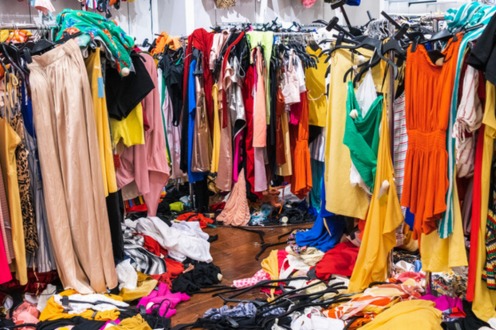While previous generations stretched last year's trends and mall brands, Generation Z is turning to online thrift websites and auction websites to find one-of-a-kind secondhand style, and, in the process, they're creating a new generation of eco-friendly fashion culture.
Let's examine why this emerging trend is happening and how online thrift auctions are becoming a mainstay of Gen Z shopping habits.

1. Sustainability Is Non-Negotiable
One of the biggest drivers of this trend is Gen Z's deep love for the planet. Fashion is one of the world's most environmentally damaging industries, with the following output:
- 10% of global carbon emissions
- 20% of wastewater
- Millions of tons of textile waste annually
Instead of promoting fast fashion, Gen Z prefers second-hand items that get clothes circulating for a longer duration. Online auctions are a low-footprint alternative, making it possible for items to be reused, re-purposed, or resold, rather than ending up in landfills.
2. The Thrill of Bidding and Winning
While static browsing resale listings or online shopping is dull, auctions are thrilling. Gen Z is fond of interactive, gamified experiences and bidding on merchandise satisfies that craving for interaction.
With countdown clocks, bidding battles, and live alerts, online auctions make shopping a social, tactical experience. This turns purchasing secondhand fashion from a passive activity to a fun and competitive experience.
3. Affordability Without Compromise
Financial literacy is also a concern. Most Gen Z consumers are students or young adults who are typically on tight budgets. Online thrift auctions offer the opportunity to:
- Buy name-brand and vintage items at below-retail prices
- Buy in bulk or lots for deals
- Avoid the markup of specially curated thrift stores
Being cheap here does not necessarily mean cheap in quality—it means more for less, without sacrificing style or ethics.
4. Uniqueness Over Uniformity
In a sea of mass-produced fashion, Gen Z values individuality. They desire one-of-a-kind pieces that reflect their personality, not what's in style this season.
Thrift auctions are a treasure trove of vintage, one-of-a-kind, and quirky clothing that is unlike anything else. It's not uncommon to find:
- 90s streetwear
- Y2K fashion
- Vintage denim
- Handmade or discontinued items
This is exactly what Gen Z needs to thoughtfully curate their wardrobe with uniqueness.
5. Digital-First, Mobile-Ready
Born and brought up on smartphone apps, Gen Z is deeply comfortable with technology.
Most web-based thrift sales are smartphone-efficient, app-operated, and easy to conduct while mobile.
This provides Gen Z shoppers with the option of surfing, bidding, and buying clothes via phone, with accessibility, convenience, and versatility.
6. Community and Social Sharing
Gen Z shoppers don't just shop, they share. Whether it's a thrift haul on TikTok or an Instagram Story of a hard-to-find auction victory, the social process of bargain shopping at thrift stores is included.
A lot of online auctioning is now organically extending naturally through social media sharing, do-it-yourself fashion content, and debates over sustainability, forming identity and a feeling of belonging within the thrifting community.
7. Fashion Literacy and Conscious Consumerism
Gen Z is also attracted to online second-hand auctions because they are becoming fashion literate. This generation isn't interested in what they're wearing—but why.
Thanks to documentaries, social media awareness, and influencers embracing sustainable lifestyle, Gen Z are educating themselves to ask:
- Who made this product?
- What are they made of?
- Is the company ethical or greenwashing?
- Can this product be reused, upcycled, or resold?
Online auctions empower them to create a wardrobe that communicates ethical choices, not blindly following fast-fashion appeal. Every bid is investing in a slower, circular consumption model.
8. A New Way to Learn About Fashion History
Online second-hand auctions are not only hassle-free, there's even an educational advantage. Most Gen Z thrift shoppers are drawn to auctions carrying vintage or era-specific pieces, giving them a practical way to learn about fashion history.

From boho 70s to grunge 90s or streetwear early 2000s, auctions are an entry point to decades of fashion. This act of mixing and matching from different eras allows Gen Z to explore self-expression through fashion evolution and create their own narratives.
This passion for the past makes them not only fashionable but also aware consumers, more concerned with timeless fashion than seasonal fashion.
9. Curbing Overproduction and Promoting a Circular Economy
Secondhand auction platform directly help curb demand for new production. Every time someone bids on a used item during an online secondhand auction, one less new product may be produced, shipped, or sold.
This is part of a broader circular economy since the lifespan of clothing is extended by:
- Resale
- Reuse
- Recycling
- Reinvestment in local selling communities
For a generation so fixated on the issue of climate change and overconsumption, this model is ideal for their environmental and economic ideals.
10. Gateway to Resale Entrepreneurship
Finally, Gen Z isn't merely buying as consumers, there's reselling and selling too. There are many who use online second-hand auction sites to:
- Get rid of stuff they no longer want
- Resell vintage finds for profit
- Establish micro-resale enterprises
- Fund their studies or side business
This entrepreneurial function shows that Gen Z possesses an independent mind and desire for fluid sources of income. Thrifting becomes not just a way of life preference, but an entrepreneurial pursuit.
Conclusion
As fashion continues to evolve, Gen Z is leading the charge towards a more conscious, intentional, and creative way of dressing. Online second-hand auctions aren't just fashionable. They're an outward expression of deeper values surrounding climate action, digital interaction, and style.
By choosing to shop second-hand through auction websites, Gen Z isn't just revolutionizing how we shop, but they're remaking what it means to be fashionable in an intentional world.